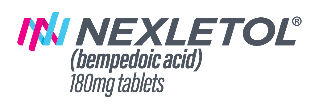-
As an adjunct to diet:
-
NEXLIZET, alone or in combination with other LDL-C lowering therapies, to reduce LDL-C in adults with primary hyperlipidemia, including HeFH.
-
NEXLETOL, in combination with other LDL-C lowering therapies, or alone when concomitant LDL-C lowering therapy is not possible, to reduce LDL-C in adults with primary hyperlipidemia, including HeFH.
|
-
NEXLIZET and NEXLETOL are contraindicated in patients with a prior hypersensitivity to bempedoic acid or ezetimibe or any of the excipients. Serious hypersensitivity reactions including anaphylaxis, angioedema, rash, and urticaria have been reported.
-
Hyperuricemia: Bempedoic acid, a component of NEXLIZET and NEXLETOL, may increase blood uric acid levels, which may lead to gout. Hyperuricemia may occur early in treatment and persist throughout treatment, returning to baseline following discontinuation of treatment. Assess uric acid levels periodically as clinically indicated. Monitor for signs and symptoms of hyperuricemia, and initiate treatment with urate-lowering drugs as appropriate.
-
Tendon Rupture: Bempedoic acid, a component of NEXLIZET and NEXLETOL, is
associated with an increased risk of tendon rupture or injury. Tendon rupture may occur
more frequently in patients over 60 years of age, in those taking corticosteroid or
fluoroquinolone drugs, in patients with renal failure, and in patients with previous tendon
disorders. Discontinue NEXLIZET or NEXLETOL at the first sign of tendon rupture.
Consider alternative therapy in patients who have a history of tendon disorders or tendon
rupture.
-
The most common adverse reactions in the primary hyperlipidemia trials of bempedoic acid, a component of NEXLIZET and NEXLETOL, in ≥2% of patients and greater than placebo were upper respiratory tract infection, muscle spasms, hyperuricemia, back pain, abdominal pain or discomfort, bronchitis, pain in extremity, anemia, and elevated liver enzymes.
-
Adverse reactions reported in ≥2% of patients treated with ezetimibe (a component of
NEXLIZET) and at an incidence greater than placebo in clinical trials were upper respiratory tract infection, diarrhea, arthralgia, sinusitis, pain in extremity, fatigue, and influenza.
-
In the primary hyperlipidemia trials of NEXLIZET, the most commonly reported adverse
reactions (incidence ≥3% and greater than placebo) observed with NEXLIZET, but not
observed in clinical trials of bempedoic acid or ezetimibe, were urinary tract infection,
nasopharyngitis, and constipation.
-
The most common adverse reactions in the cardiovascular outcomes trial for bempedoic
acid, a component of NEXLIZET and NEXLETOL, at an incidence of ≥2% and 0.5%
greater than placebo were hyperuricemia, renal impairment, anemia, elevated liver
enzymes, muscle spasms, gout, and cholelithiasis.
-
Concomitant use of NEXLIZET or NEXLETOL with greater than 20 mg of simvastatin or
40 mg of pravastatin should be avoided due to the potential for increased risk of
simvastatin- or pravastatin-related myopathy.
-
Discontinue NEXLIZET or NEXLETOL when pregnancy is recognized unless the benefits
of therapy outweigh the potential risks to the fetus. Because of the potential for serious
adverse reactions in a breast-fed infant, breastfeeding is not recommended during
treatment with NEXLIZET or NEXLETOL.
|




